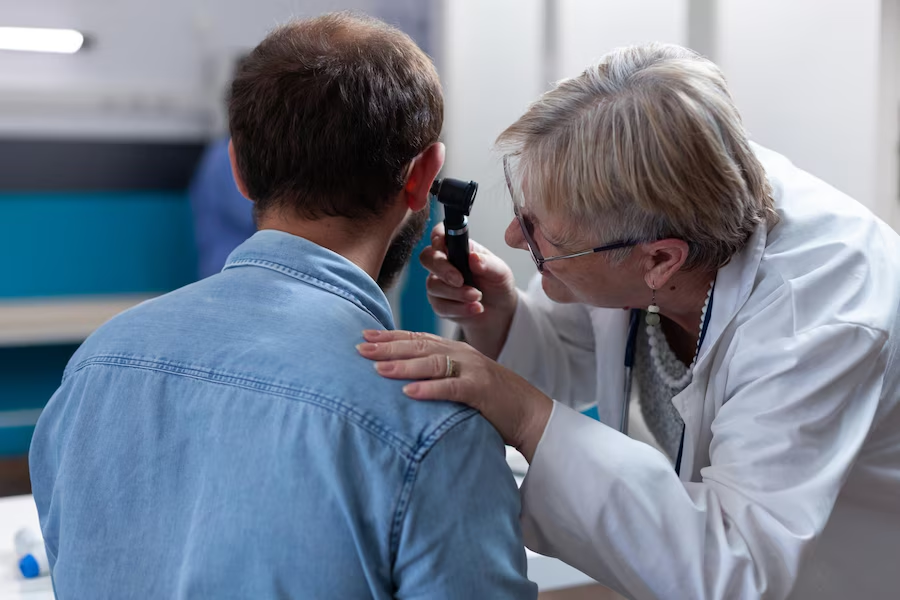
Ear irrigation is a crucial clinical skill for nurses and carers working in various healthcare settings across the UK. This procedure, when performed correctly, can significantly improve patient comfort and hearing ability by removing excess earwax (cerumen).
The risk of complications from irrigation requiring specialist referral is estimated at 1 per 1000 cases. The National Institute for Health and Care Excellence (NICE) recommends that earwax removal services should be available in primary care
This guide will cover the essential aspects of developing and maintaining ear irrigation skills in accordance with UK healthcare standards and best practices.
Legal and Professional Requirements
Training Requirements
- Completion of approved ear irrigation training course
- Understanding of NICE guidelines regarding ear irrigation
- Regular updates and competency assessments
- Familiarity with local NHS Trust policies
- Documentation of training and continuous professional development
Professional Standards
- Adherence to NMC (Nursing and Midwifery Council) guidelines
- Compliance with Care Quality Commission (CQC) standards
- Understanding of clinical governance requirements
- Maintenance of professional indemnity insurance
Essential Knowledge Base
Anatomy and Physiology
- External ear structure:
- Pinna
- External auditory canal
- Tympanic membrane (eardrum)
- Common conditions:
- Cerumen impaction
- Otitis externa
- Perforated eardrum
- Foreign body presence
Contraindications
- Absolute contraindications:
- Previous ear surgery
- Perforated eardrum
- History of ear infections
- Presence of grommets
- Relative contraindications:
- Diabetes
- Immunocompromised status
- Previous complications from ear irrigation
- Dizziness or vertigo
Equipment and Materials
Essential Equipment
- Electric ear irrigator (approved model)
- Temperature control mechanism
- Pressure control system
- Disposable tips
- Personal Protective Equipment (PPE):
- Disposable gloves
- Apron
- Eye protection
- Face mask
- Additional supplies:
- Towel
- Receiver
- Cotton wool
- Tissue paper
- Documentation materials
Maintenance and Safety
- Equipment checks:
- Daily function tests
- Temperature calibration
- Pressure settings verification
- Clean water system
- Infection control:
- Sterilisation procedures
- Single-use components
- Environmental cleaning
- Waste disposal
Pre-Procedure Assessment
Patient Assessment
- Medical history review:
- Previous ear problems
- Recent infections
- Surgical history
- Current medications
- Physical examination:
- Otoscopy skills
- Recognition of normal anatomy
- Identification of abnormalities
- Assessment of wax impaction
Risk Assessment
- Patient factors:
- Age
- Cognitive status
- Physical mobility
- Anxiety levels
- Environmental factors:
- Adequate lighting
- Appropriate room temperature
- Privacy considerations
- Emergency equipment access
Procedure Technique
Preparation
- Patient preparation:
- Explain procedure
- Obtain informed consent
- Position patient correctly
- Protect clothing
- Environment preparation:
- Gather all equipment
- Ensure good lighting
- Check water temperature
- Position receiver
Irrigation Technique
- Basic steps:
- Initial otoscopy
- Water temperature verification
- Correct angle positioning
- Gentle irrigation
- Advanced skills:
- Pressure control
- Flow rate adjustment
- Recognition of complications
- Emergency response
Post-Procedure Care
- Immediate care:
- Dry ear canal
- Final otoscopy
- Patient comfort check
- Aftercare instructions
- Documentation:
- Procedure details
- Outcomes
- Complications
- Follow-up plans
Developing Clinical Expertise
Skill Enhancement
- Practice techniques:
- Simulation training
- Supervised practice
- Peer observation
- Case reviews
- Knowledge expansion:
- Current research
- Best practice updates
- Professional forums
- Clinical guidelines
Problem-Solving Skills
- Common challenges:
- Difficult wax removal
- Patient anxiety
- Equipment issues
- Time management
- Solution strategies:
- Alternative techniques
- Patient reassurance
- Technical troubleshooting
- Efficiency improvements
Patient Communication
Pre-Procedure Information
- Explanation:
- Procedure steps
- Expected sensations
- Potential risks
- Expected outcomes
- Patient education:
- Ear health maintenance
- Prevention strategies
- Warning signs
- Follow-up care
During Procedure
- Continuous communication:
- Progress updates
- Comfort checks
- Clear instructions
- Reassurance
- Non-verbal communication:
- Body language
- Eye contact
- Facial expressions
- Professional demeanor
Quality Assurance
Audit and Review
- Regular assessments:
- Competency checks
- Documentation review
- Patient feedback
- Outcome monitoring
- Quality improvement:
- Protocol updates
- Equipment evaluation
- Training needs assessment
- Service development
Risk Management
- Incident reporting:
- Recognition of complications
- Documentation procedures
- Investigation process
- Learning outcomes
- Prevention strategies:
- Risk assessment
- Protocol adherence
- Equipment maintenance
- Staff training
Professional Development
Continuing Education
- Formal training:
- Advanced courses
- Specialist workshops
- Online modules
- Conference attendance
- Informal learning:
- Peer discussion
- Case studies
- Journal reviews
- Clinical supervision
Career Progression
- Specialisation opportunities:
- ENT nursing
- Practice nursing
- Clinical education
- Service leadership
- Professional networking:
- Professional associations
- Special interest groups
- Online communities
- Mentorship programmes
Conclusion
Developing ear irrigation skills requires a combination of theoretical knowledge, practical experience, and continuous professional development. Success in this clinical area depends on:
- Thorough understanding of anatomy and physiology
- Strict adherence to safety protocols
- Excellence in patient communication
- Commitment to ongoing learning
- Regular practice and skill refinement
By following these guidelines and maintaining professional standards, nurses and carers can provide safe, effective ear irrigation services while continuing to develop their expertise in this important clinical skill.
Resources and References
- NICE Guidelines for Ear Wax Removal
- NMC Standards of Practice
- Royal College of Nursing Clinical Resources
- Local NHS Trust Protocols
- Professional Journal Articles and Research Papers
Write and Win: Participate in Creative writing Contest & International Essay Contest and win fabulous prizes.


